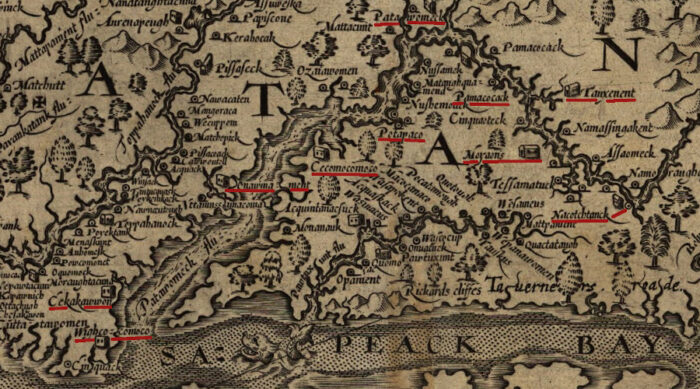
I recently wrote an overview of what we know about the indigenous people of Washington D.C. and Capitol Hill in particular. Today, in honor of Indigenous People’s Month, is the first of a series of articles looking more closely at what we know about them.
The earliest account of those living on what would become the District of Columbia comes from Captain John Smith (that’s him on the left) in his 1624 book The Generall Historie of Virginia, New-England, and the Summer Iles. During his description of the area gleaned from his time in Virginia from 1607 to 1609, he wrote about the Potomac River and the tribes living on it:
The fourth river is called Patawomeke, 6 or 7 myles in breadth. It is navigable 140 myles, and fed as the rest with many sweet rivers and springs, which fall from the bordering hils. These hils many of them are planted, and yeeld no lesse plentie and varietie of fruit, then the river exceedeth with abundance of fish. It is inhabited on both sides.
He then lists nine different tribes and their approximate strength, before ending with:
And lastly, Nacotchtanke with 80. The river aboue this place maketh his passage downe a low pleasant valley overshaddowed in many places with high rocky mountaines; from whence distill innumerable sweet and pleasant springs.
In other sections of the book, not written by Smith himself, but collected into his work, he quotes William Simons who tells of traveling up the Potomac river and meeting numerous tribes, including the “Nacotchtant” – even within this single book, there is no attempt to normalize the spelling of the word. Simons describes meeting native Americans in canoes piled high with “Beares, Deere and other beasts,” which he and his fellow ship-mates ate.

Later descriptions (all from the same book) are not nearly as positive, as one written by John Pory in 1609, where he writes about visiting the “Patawomeke” in search of corn, which the king of the tribe professed not to have. Instead, he said that the “Nacotchtanks and their confederats” had plenty, and since they were his sworn enemies, he would be happy to send along a number of expert archers to help take their goods.
The plan was successful, with the natives and the English killing a number of the Nacotchtanks and driving the rest away, allowing them to take what they needed and “spoiling the rest.”
A map that Smith included in his book shows the location of the Nacotchtank village, in Southwest DC between what is today Joint Base Anacostia-Bolling and Anacostia.
The most famous interaction with the Nacotchank came in 1621, when the ship Tiger sailed from Jamestown to trade along the Potomac river. They were attacked by members of the Nacotchtank and those who were not killed were taken prisoner. Among the latter was Henry Fleet, who lived with his captors for some five years before returning to the settlers. His knowledge of the local tribes would later be help get the Maryland colony started.
These colonies would, of course, spell the end of the Nacotchtank in the area. As land was parceled out and converted to tobacco plantations, the original inhabitants were forced out, first to Analostan Island (today Theodore Roosevelt Island) and then further west. Today, no members of the tribe are known to exist.
Over the next weeks, I will look at some of the non-textual evidence that we have of the area’s first inhabitants.
